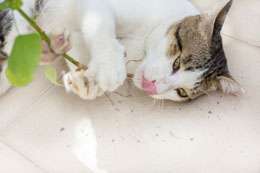For a cat owner, growing indoor plants that are safe for cats is the top priority while planning for a green environment. While catnip and cat grasses are preferred, you can also grow other non-toxic indoor plants.

We cannot even think of decorating our house without a green touch. But, what if the houseplants are poisonous to your pets? Yes, it is quite possible. As cats have a natural tendency to nibble and bite things that come in their way, you should be very careful while choosing plants for your interiors. Selecting feline-safe indoor plants ensures that you enjoy the company of your adorable pet, as well as maintain a green environment in and around the house.
If you are a proud owner of cuddly cats, you will agree that these carnivores love to have some greens in their diet. The point is, most of them target houseplants just for the fun of chewing them, or to satisfy their appetite at times of hunger. Whatever the case, you are responsible for identifying cat-friendly plants for your house. For your reference, some of the common ones are listed below.
Catnip Plants
Amongst the various indoor plants considered safe for cats, the best of all is catnip. Belonging to the mint family, it is a perennial herb that possesses fragrant essential oils. About 250 species of catnip are identified, excluding the hybrid cultivars. Of these, the common catnip variety that bears white flower is the most preferred by cats. There are also pink and purple flowering catnip species, which you can grow indoors.
Cat Grasses
It is believed that this type of grass provides folic acids and other essential vitamins, which are lacking in the regular cat diet. Also, grasses are a rich source of fiber, that helps in ensuring a healthy digestive system for your pet. In nearly all plant supply centers and nurseries, you will get potted grasses grown from organic seeds, especially sold for cats.
African Violet
In case you are looking for colorful blooms that get along well with cats, try African violets. Remember to keep the containers in an isolated spot, where the cat cannot reach. If your cat eats the leaves and flowers, it won't be harmed in any way. These indoor plants need sufficient water for timely blooming.
Pansy Flowers
Another cat-safe indoor plant is the flowering pansy. Many of you might be aware that these vibrantly colored blooms are edible for humans, and they are not dangerous for cats too. However, do not encourage your cat to nibble on the foliage and flowers. After all, you plant the pansies to enjoy their flowers, not for feeding cats.
Orchid Plants
Orchids are some of the most preferred houseplants for hobbyists. Hence, whether they are safe for cats is a common query that lingers in the mind of pet owners. Nearly all varieties of orchids are safe for cats. Do not believe in the rumor that orchids cause allergic reactions in pets. You can include exotic orchids in your interior decor without hesitation.
Other Plants
Wheatgrass is healthy not only for us, but for cats too. You can sow already soaked, organic wheat seeds in a large container with the regular potting soil. Water lightly and cover them with a newspaper to promote germination. After the seeds have sprouted, remove the newspaper, and keep the pot near a window. In addition, other options are thyme, coriander, sage, spider plant, snapdragon, peppermint, and rosemary.
Speaking about plants poisonous to cats, some of them include daffodils, aloe vera, azalea, amaryllis, croton, cycad, cyclamen, English ivy, kalanchoe, and peace lily. So, exclude these from your indoor gardening project. In case you suspect that your cat has consumed toxic indoor plants, do not delay in getting the veterinarian's attention. Some plants can cause irreversible cat health problems, like digestive discomfort, kidney damage, and heart complications.
Select only those plants that are safe for cats, and create a problem-free environment for your pet. For additional info, you can take the advice of a local horticulturist. For pet owners who are worried about constant damage to houseplants, placing them above the ground level or at an inaccessible spot will help in protecting them. Another easy tip is to put double-sided sticky tape or glue around the pots to discourage the pets from approaching the plants.






 We cannot even think of decorating our house without a green touch. But, what if the houseplants are poisonous to your pets? Yes, it is quite possible. As cats have a natural tendency to nibble and bite things that come in their way, you should be very careful while choosing plants for your interiors. Selecting feline-safe indoor plants ensures that you enjoy the company of your adorable pet, as well as maintain a green environment in and around the house.
We cannot even think of decorating our house without a green touch. But, what if the houseplants are poisonous to your pets? Yes, it is quite possible. As cats have a natural tendency to nibble and bite things that come in their way, you should be very careful while choosing plants for your interiors. Selecting feline-safe indoor plants ensures that you enjoy the company of your adorable pet, as well as maintain a green environment in and around the house.